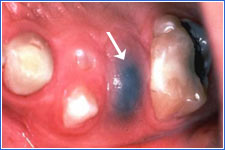Post-Test: Child Oral Health Assessment
| Time to Take the Assessment |
To receive a certificate, you must answer all 10 questions and click “Finish Quiz” to see your score. You must score 80% or higher to receive CME credit and a certificate. Once you have completed the quiz and scored 80% or higher, a button will appear at the bottom of the page that will allow you to print your certificate. Click “Start Quiz” below to take the final assessment. |
Need More Information?
The Smiles for Life website contains a listing of recommended websites. These sites are excellent sources of information on oral health for primary care clinicians.
To receive credit for this course you must score a minimum of 80% on this assessment. If you do not score a minimum of 80%, you will have to retake the test in order to receive credit. Message from the AAPA: Successful completion of the self-assessment is required to earn Category 1 CME credit. Successful completion is defined as a cumulative score of at least 70% correct. Smiles for Life requires 80% to pass.
Quiz Summary
0 of 10 Questions completed
Questions:
Information
You have already completed the quiz before. Hence you can not start it again.
Quiz is loading…
You must sign in or sign up to start the quiz.
You must first complete the following:
Results
Results
0 of 10 Questions answered correctly
Your time:
Time has elapsed
You have reached 0 of 0 point(s), (0)
Earned Point(s): 0 of 0, (0)
0 Essay(s) Pending (Possible Point(s): 0)
Categories
- Not categorized 0%
- 1
- 2
- 3
- 4
- 5
- 6
- 7
- 8
- 9
- 10
- Current
- Review
- Answered
- Correct
- Incorrect
-
Question 1 of 10
1. Question
What is Early Childhood Caries?
CorrectIncorrect -
Question 2 of 10
2. Question
Oral bacteria and dietary sugars are two of the three parts of the “Etiology Triad” of Early Childhood Caries. What is the third part of the triad?
CorrectIncorrect -
Question 3 of 10
3. Question
What is a risk factor for developing Early Childhood Caries?
CorrectIncorrect -
Question 4 of 10
4. Question
How can primary care clinicians help prevent Early Childhood Caries?
CorrectIncorrect -
Question 5 of 10
5. Question
The mother of your 10-month-old patient asks about a prescription for supplemental fluoride. She reports that the family obtains their water from a well. What is your best course of action?
CorrectIncorrect -
Question 6 of 10
6. Question

What does this photograph of a child’s mouth depict?
CorrectIncorrect -
Question 7 of 10
7. Question

To what is the arrow pointing on this photograph of a child’s mouth?
CorrectIncorrect -
Question 8 of 10
8. Question
What is the first step in performing a knee-to-knee examination of a child’s mouth?
CorrectIncorrect -
Question 9 of 10
9. Question
What guidance about teething should a primary care clinician provide to a toddler’s caregiver?
CorrectIncorrect -
Question 10 of 10
10. Question

The arrow is pointing to a darkened feature in a child’s mouth.
What is this finding called?CorrectIncorrect